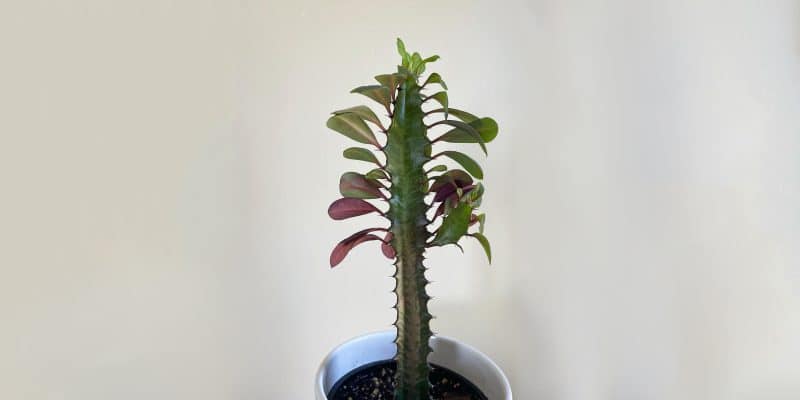The African Milk Tree, or African milk bush, is a spiky beauty that’s like a combination of a cactus and a modern art sculpture — and yet it’s surprisingly easy to care for.
Don’t let its spiky exterior fool you; the African Milk Tree is a unique and friendly addition to your collection. It towers above your other plants — as tall as 9 feet, in fact. Despite its size, though, it grows extremely well as a container plant.
We’ll delve deep into all aspects of African Milk Tree care, from its preferred environment to propagation and how to solve any common issues that might crop up.
Table of Contents
African Milk Tree Plant Care Guide
History, Habitat, and Characteristics
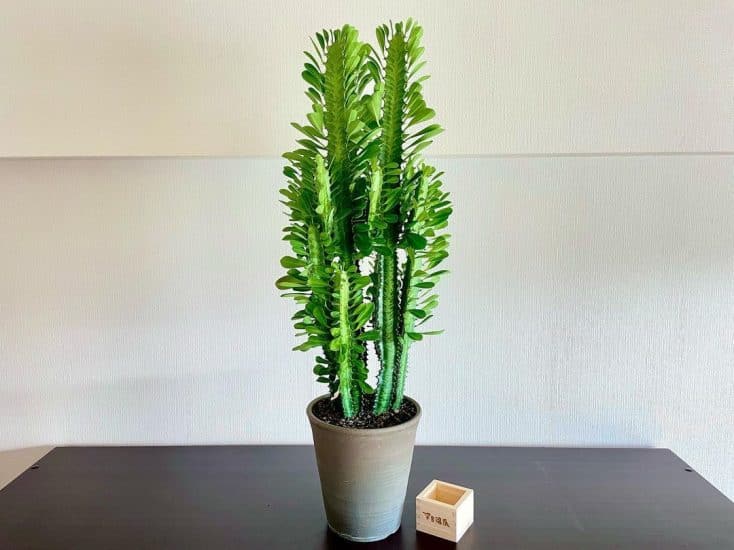
Hailing from the arid climates of West and Central Africa, the African Milk Tree (Euphorbia trigona Mill.) is a strikingly architectural perennial plant with triangular stems and leaves that make their home among a column of sharp thorns.
The African Milk Tree earned its name from the milky sap it releases when cut or damaged. Turns out this sap has uses in traditional medicine, but beware — it’s toxic if ingested and may even irritate your skin.
Euphorbia trigona comes in two dazzling varieties: the classic green and the vibrant Euphorbia trigona ‘Rubra,’ boasting shades of red and green. For plant collectors looking to spice things up, don’t overlook the variegated euphorbia. This version, which features a dappled complexion, has spiky stems, quick growth, and specific lighting needs.
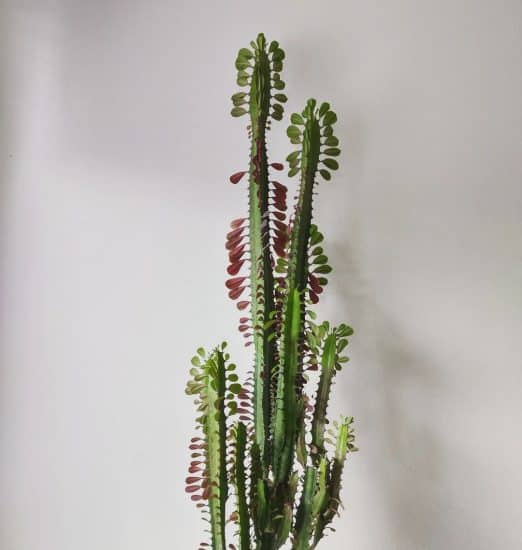
Before we move on to how to care for Euphorbia trigona, there’s one thing you should be sure of, and it may surprise you — this plant is not a cactus, it’s a succulent.
The African Milk Tree plant has no shortage of misleading nicknames. From cathedral cactus to good luck cactus, as well as candelabra cactus, euphorbia cactus, and friendship cactus, all these nicknames are misnomers.
Where cacti have spines, plants in the Euphorbia genus have thorns. Where cacti have a clear sap, euphorbia plants have a milky sap. Other differences include regions of origin and flowering habits. But one thing remains clear — the African Milk Tree plant is NOT a cactus!
Light
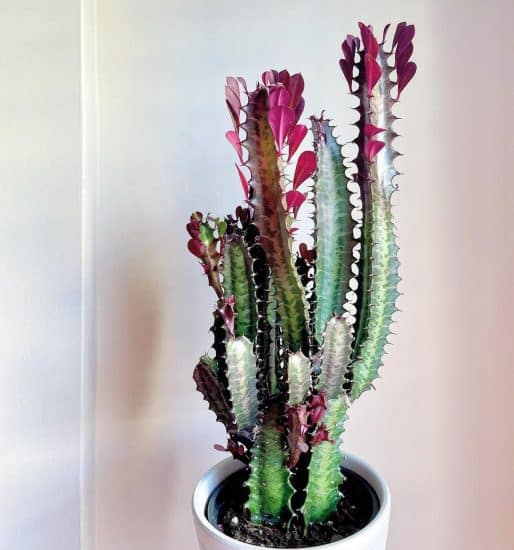
African Milk Tree plants love bright light, especially when grown as indoor plants. A bit of direct sun each day will help your African Milk Tree thrive. But if you move it outdoors in summer, it’s best to give it partial shade and protect it from harsh outdoor full sun.
You may find that the variegated Euphorbia trigona plant needs more light than its uniform brethren in order to branch out and grow healthy. No matter the variety, to give your indoor plant the light it needs, find a spot with the right balance of bright light, such as a southern-facing window.
African Milk Tree will live well enough in bright indirect sunlight, but if it isn’t getting enough bright sunlight, you’ll see slow and leggy growth. The plant might even stretch toward the light source and start showing faded leaves. Move the plant to a spot with brighter light and let it get a bit of direct light each day.
On the other hand, too much full sun can cause trouble for your African Milk Tree plant. Its leaves may become sunburned, showing a faded or scorched appearance. In this case, you can either move the plant to a gentler light source or use a sheer curtain to filter the strong sunlight.
Our lighting tips:
- Place your plant in an area with bright light and a bit of direct sun.
- Outdoors, keep your Euphorbia trigona plant in partial sun.
- Keep your plant safe from too much direct sun by moving it away from harsh rays, or use a sheer curtain for a softer touch.
- Rotate your Euphorbia trigona every few weeks for even exposure to the light.
Water
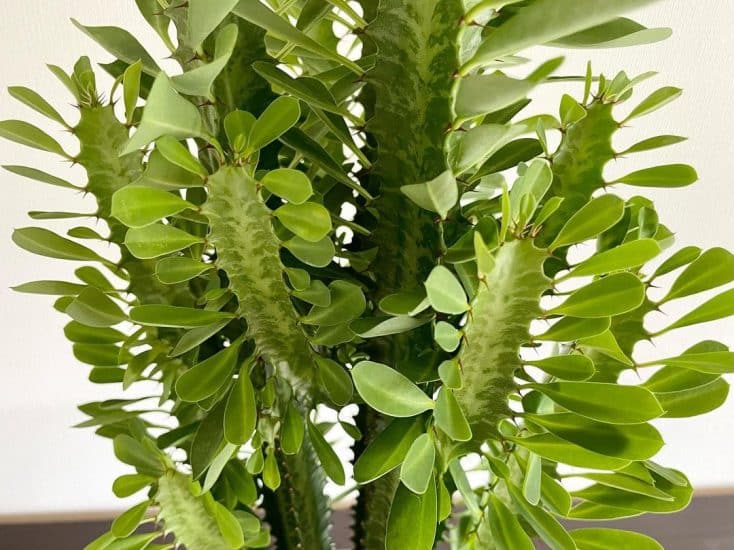
The Euphorbia trigona is a drought-tolerant plant. To keep yours happy, make sure the soil dries out between waterings.
How often you need to do this will depend on your climate, the size of the plant, and the type of pot it’s in. Once a week will probably be too much except in the throes of summer and a lot of direct sunlight.
Keep in mind that the variegated variety of this plant is more drought-tolerant than the regular and can go longer periods without water. As a rule of thumb, underwatering is the lesser evil when compared to overwatering, since too much water can cause problems like stem rot.
If your African Milk Tree plant isn’t getting enough water, you might see wilting, drooping leaves, or a wrinkled appearance on the stems. In this case, it’s time to increase the frequency of your watering schedule.
On the other hand, if you’re overwatering — the far more likely scenario — you’ll notice yellowing leaves, soft and mushy stems, and a not-so-pleasant smell coming from a consistently wet soil. These symptoms indicate that your plant is suffering from excessive moisture.
To fix this, cut back on the watering frequency and allow the soil to dry out.
Our watering tips:
- Water when the soil has dried out completely.
- Ensure proper water drainage.
- Keep an eye out for signs of underwatering, such as wilting and wrinkled stems.
- Watch for signs of overwatering, like yellowing leaves, mushy stems, and unpleasant-smelling soil.
- Remember, it’s better to underwater than to overwater this particular succulent plant.
Temperature and Humidity
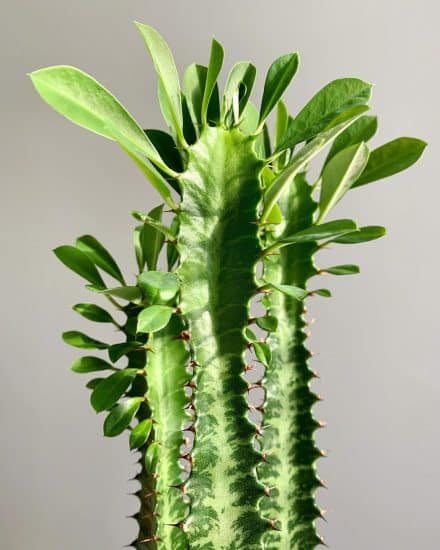
The African Milk Tree is comfortable in a temperature range of 64°F to 77°F (18°C to 25°C). Make sure to keep your plant away from cold drafts, especially during the winter months when it needs winter protection.
On the other hand, if you notice your plant wilting in a warm environment, it might be exposed to temperatures that are too high.
These drought-tolerant plants can handle humidity levels down to 20%, but they can adapt to thrive in higher levels as well. Still, you won’t need to worry about increasing humidity around this plant. In fact, it’s best to keep it in a different area of your home than your humidity-loving plants.
If your Euphorbia trigona gets too much humidity, it’ll display yellowing of the leaves or drop its leaves, and it’ll be more susceptible to diseases, such as fungus. Make sure the circulation around your euphorbia plant is good and that it’s not in an excessively wet room.
Our temperature and humidity tips:
- Keep your African Milk Tree within a temperature range of 64°F to 77°F (18°C to 25°C), and avoid cold drafts and extreme heat.
- Maintain an average indoor humidity level of around 20% or higher, but don’t fuss about increasing humidity.
- Check your plant’s leaves regularly for signs of too low or too high humidity levels, and adjust your care accordingly.
Soil and Planting
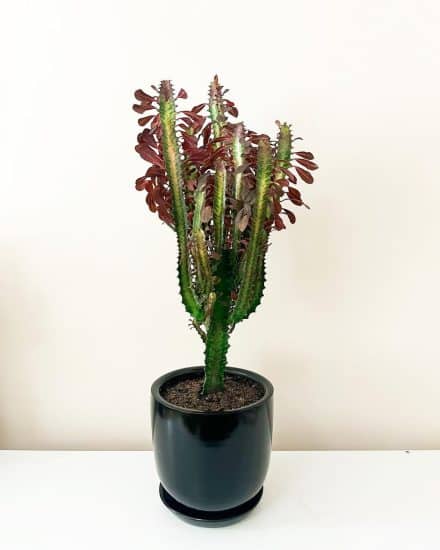
As a drought-tolerant plant, Euphorbia trigona needs a sandy soil that drains well. The ideal soil mix for this perennial plant includes a well-draining cacti-succulent mix with some added sand and grit.
For optimal drainage, use a porous clay pot, like a terracotta pot. Avoid ceramic or plastic pots, which tend to retain too much moisture in the soil.
Signs of poor soil and the issues that can arise with the wrong potting mix for your Euphorbia trigona include yellowing leaves, stunted growth, and root issues. If you notice any of these symptoms, consider repotting your African Milk Tree into a more suitable soil mix.
The Euphorbia cactus doesn’t require frequent repotting. It can grow quite tall and still maintain stability. However, if you notice its shallow root system becoming pot-bound or the soil quality has diminished, it may be time to consider repotting. Just don’t go too much bigger. The roots don’t need a lot of extra space and, in fact, too much space can lead to overwatering.
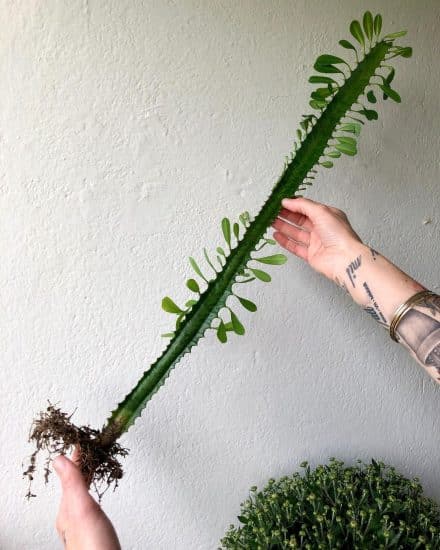
The ideal time to repot is during the plant’s growth season, typically in the spring. Choose a container that’s only slightly larger than the previous one to avoid the risk of root issues, and ensure it has drainage holes for proper aeration.
Fertilizer
During the plant’s growing season, apply a balanced (NPK) slow-release fertilizer and flush with clean, room-temperature water every few months to prevent salt from building up in the soil.
Too much fertilizer can also cause problems for your plant. Signs of over-fertilizing include leaf scorching, yellowing leaves, and weak, spindly growth.
To resolve this issue, flush the soil with clean water to leach out any excess fertilizer salts, and adjust your fertilizing schedule.
Propagation Guide
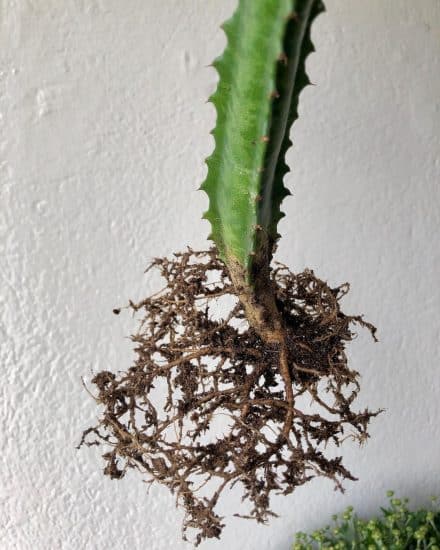
Ready to make more African Milk Trees so your friends can have their own succulent gardens? Like other succulent plants, Euphorbia trigona is easy to propagate by cuttings.
Propagating African Milk Tree plants via cutting:
- Make a cutting. With a sterile knife or a pair of shears, snip a 4-6 inches long section from your healthy parent plant. Aim for at least 2-3 lush leaves on your cutting. Let the cutting rest and callus over for about 1-3 days.
- Plant it in the soil. When the cut end is ready, poke the cutting into some sandy, well-draining potting soil. Double-check that the right end is facing up! Give the soil a gentle press to keep your cutting snug and secure.
- Find its forever home. Move the cutting to a spot with bright sunlight. Keep direct sunlight at bay while it’s young so it doesn’t sap your cutting’s energy or leave your leaves crispy.
- Step away from the watering can. Hold off on watering your cutting for the first several days. This gives the cutting time to adjust without drowning it in moisture.
- Sprinkle some TLC. After a timeout, water your Euphorbia trigona baby thoroughly, then again when the soil dries out. In no time, you’ll have a happy little cutting sprouting roots and new growth!
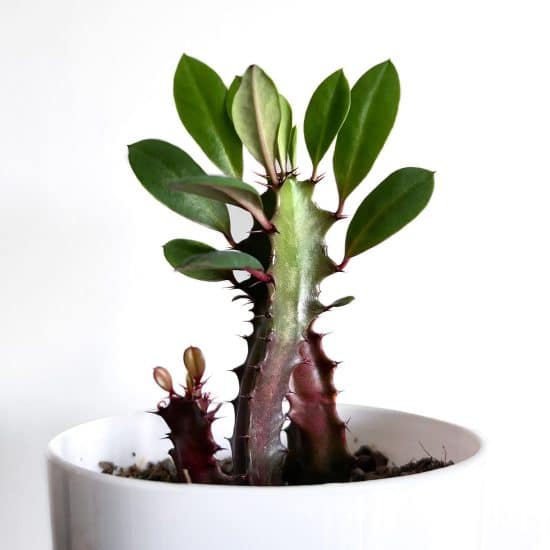
Our propagation tips:
- Sterilize your knife or shears, folks! Using clean cutting tools nips plant infections in the bud.
- Growing plants takes patience. Give your cutting a few weeks to get its roots in order before looking for new growth.
- Spring or summer are ideal for propagation. Get those cuttings going during the growing season to boost your chances of success.
Common Issues
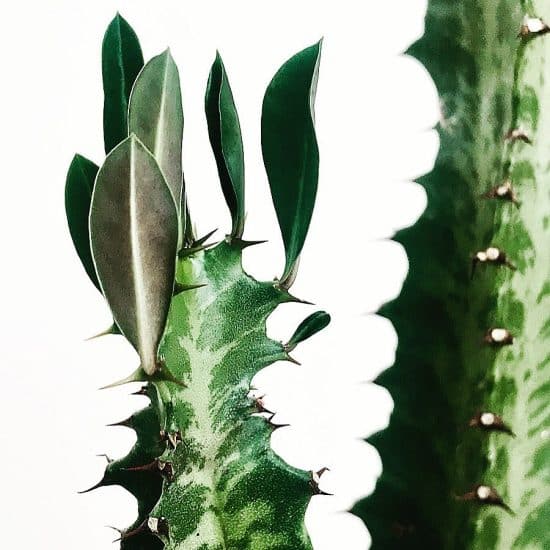
Leaf Drop
Some dropping of leaves is normal, but overwatering and underwatering African Milk Tree are common causes of excessive leaf drop. If you see other signs of stress, like drooping or mushy stems, or speedy yellowing, evaluate your care methods.
If you’re watering too much, your plant’s roots will sit in soggy soil and risk root rot and plant death. Make sure you’re watering when the soil dries out — as soon as the soil dries out. It likes to be dry, but not forever.
If you’re certain your watering is on point, take a closer look at your plant’s stems and leaves to be sure you’re not dealing with a pest or fungal infection.
Thin, Stretching Growth
This is a sign your African Milk Tree needs more sunlight. It’s your cue to move it to a sunnier spot or introduce a grow light.
But hey, be careful about overdoing it with sunlight. These guys appreciate some sun, but too much direct exposure might burn or discolor their precious leaves. It’s all about striking that perfect balance. It’s a good idea to increase any plant’s sun exposure gradually. You don’t want to shock it.
Pests and Diseases
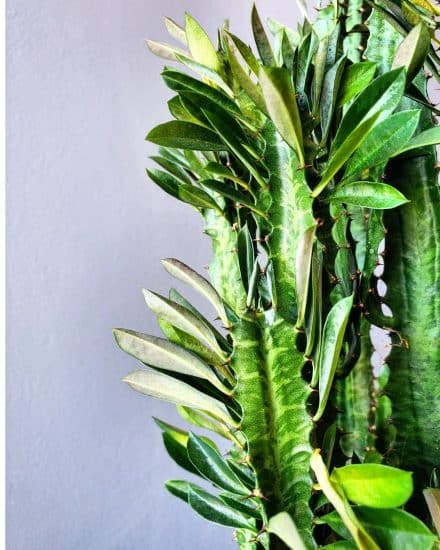
Let’s talk about some common pests and diseases that can plague an otherwise healthy plant.
Mealybugs, Scale, and Spider Mites
Got some tiny, fuzzy white bugs, thin webbing, or small round brownish insects hanging around your African Milk Tree? Well, those would be mealybugs, scale, or spider mites.
These little troublemakers feed on your plant’s sap, which weakens it over time and can even cause dropped leaves, stunted growth, and, eventually, death of the plant.
If you see clusters of these tiny insects or their cotton-like residue, it’s time to help your plant out. To evict these unwanted guests, first, make sure to separate your plant from any others you have so the bugs don’t spread. Next, grab a cotton swab dipped in rubbing alcohol or soapy water and carefully remove the bugs.
Still got a bunch? You might need to bring in the big guns — neem oil or another biological insecticide will do the trick (just follow the directions on the label).
To make sure these critters don’t come back, keep up with good care practices (like proper sunlight and watering), and give your plant a once-over now and then to spot any signs of pests.
Root Rot
A common issue for houseplants like African Milk Trees, this happens when potted plants sit in wet soil, and they start to, well, rot. This damage can then spread to the rest of your plant, resulting in wilting, yellowing leaves, and overall poor health.
To check if your plant’s roots are suffering, gently remove it from its pot and take a look… Do you see any mushy, slimy, brown or black roots? You might even smell something off coming from the soil.
To help your plant recover, first cut away any rotten roots with sterilized scissors (you don’t want to spread any infections). Then, repot your plant in fresh, well-draining soil — add some perlite, pumice, or LECA to help with drainage.
And don’t forget to use a terracotta pot with drainage holes; standing water is a big no-no for these plants.
To keep root rot at bay, only water your African Milk Tree when the soil has dried out, and make sure it’s never sitting in water. Keep an eye on its roots for any signs of rot and adjust your care routine as needed.
Conclusion
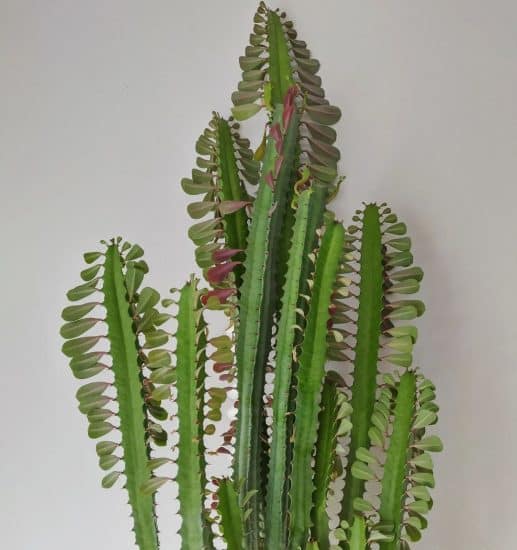
That’s a wrap for our African Milk Tree guide! With its striking looks and unique growth habit, this succulent is sure to be a conversation starter in your home or garden. Follow our care tips to keep your Euphorbia trigona happy and healthy.
African Milk Tree care summary:
- Provide bright sun with a bit of direct sunlight and some partial shade — even more for the variegated variety, which needs very high light levels.
- Water when soil is completely dry.
- Maintain temperatures between 64°F to 77°F (18°C to 25°C) and an average indoor humidity level of around 20% or higher.
- Use well-draining soil, and ensure your pot has proper drainage to avoid root and stem rot.
- Propagate through cuttings when desired, following our step-by-step guide.
We hope this guide has you super excited to care for your very own African Milk Tree. If you have any questions or concerns, feel free to reach out to us.
And if you found this guide helpful, please share it with your fellow plant lovers. Happy growing!
FAQ
Can I put my African Milk Tree outside?
Sure thing! The variegated variety especially prefers brighter light and will thrive outdoors. Just make sure to put it in indirect sunlight outdoors, since these guys will scorch in direct sun.
Can I cut the top off my African Milk Tree?
Yes. Like Henry VIII’s advisors, if you’d like to behead your darling, we certainly won’t stop you. But seriously, if you find your tree is getting too top-heavy or simply too tall for your space, you can prune the top and propagate the cuttings. This has the added bonus of also encouraging branching, a feature that probably contributed to the nickname “cathedral cactus”!
Is the African Milk Tree a cactus?
No. Although its spines make it resemble a cactus, the candelabra cactus is technically a succulent plant. What’s the difference, you ask? It’s all about stems versus leaves. Cacti have fleshy stems that hold water and photosynthesize. Succulents store nutrients and water in their fleshy leaves instead.

